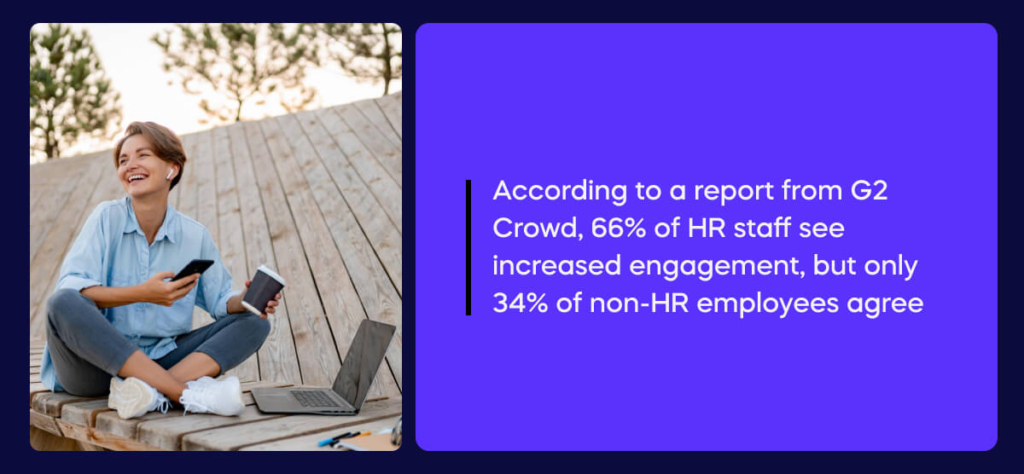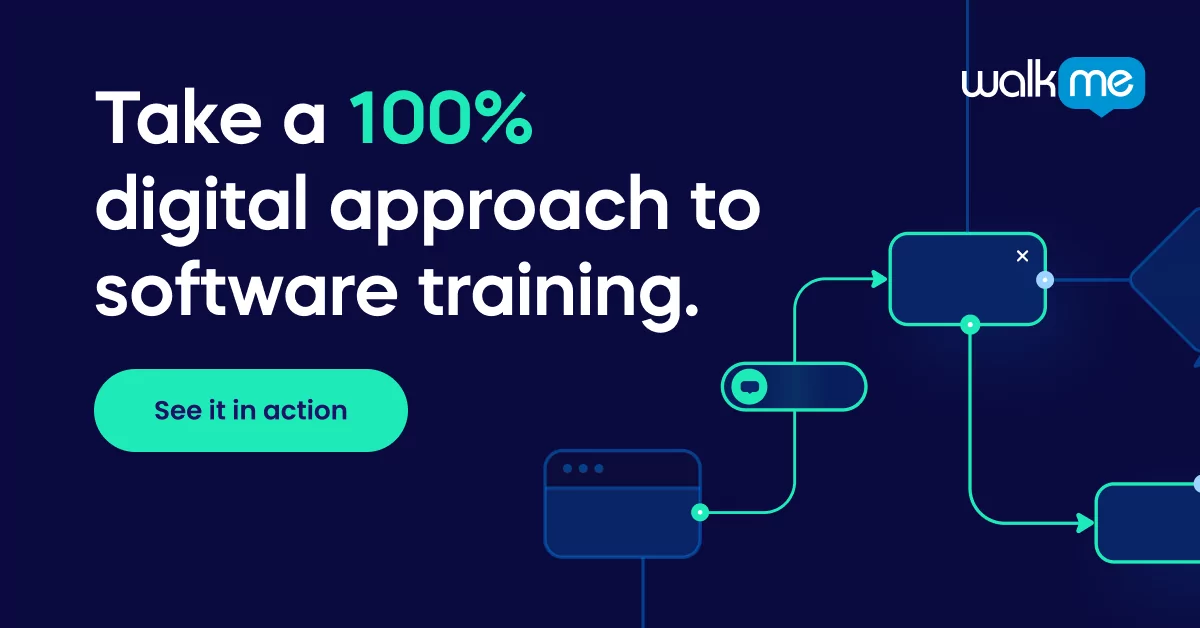The workplace is evolving and HR professionals need to keep up with the times. While the pandemic forced remote work into the mainstream, the virtual office is here to stay. It’s a trend that has already shifted the way we perceive work, with flexible work policies ranking as the third most crucial consideration for job seekers.
According to Forbes, 2.6 million Americans will work virtually by 2025, and 16% of companies operate fully remotely. And 98% of workers reported that they wanted to work remotely for at least some time.
However, despite this shift in the way we perceive office, remote work’s connection to the mission and purpose of their organization has deteriorated, according to a report by Gallup.
So how can HR address this problem? Implementing effective employee engagement strategies can be an effective solution.
What is virtual employee engagement?

Virtual employee engagement refers to the strategies, activities, and initiatives organizations use to foster connection, collaboration, and a sense of community among remote or distributed employees. In essence, they are designed to assist remote workers to feel more connected and engaged with their role.
They include virtual team-building exercises, online social events, digital communication tools, and remote employee recognition programs. The overarching goal of these strategies is to maintain high morale, productivity, and organizational culture in a remote work environment, where traditional in-person interactions are limited.
Here’s a list of virtual employee engagement ideas that you can implement in your workforce to boost morale and productivity today.
20 virtual employee engagement ideas for remote workers
- Create an engaging onboarding experience
Onboarding is the first step in the virtual employee engagement journey, and shouldn’t be overlooked by HR professionals. It’s the first impression a new hire will have on the company, so it’s important to leave a good impression.
Let’s face it, the first day in the office can be nerve-wracking, even if it’s remote. An effective onboarding not only leaves new employees at ease, but it can improve engagement and productivity and can lead to a higher retention rate too.
To ensure an engaging onboarding experience for new hires, HR leaders should use a comprehensive onboarding checklist to guide them through the company’s processes. It’s also crucial to encourage new hires to contribute ideas or feedback early, establish clear performance expectations, and create an internal network that promotes your company’s values and culture.
- Implement tools to make employee communication seamless
HR executives can use several digital tools to improve employee engagement and build a strong internal network. This type of software not only allows seamless communication between management and new hires but also helps to promote a sense of community among employees.
Slack is a popular communication tool used across teams and promotes virtual employee engagement. The many benefits of Slack include: allowing users to customize their profiles and notifications depending on their role. Other tools to ensure smooth virtual employee communication include Betterworks, 15Five, Officevibe, and Tinypulse.
- Introduce virtual TED talk discussions
TED talk discussions can be another effective way of boosting virtual employee engagement. This idea is fairly self-explanatory: scheduling time for coworkers to discuss TED talks and other thought-provoking content across their team.
These activities not only promote a sense of community across the team but also inspire employees to pursue personal growth and leadership.
- Help create a productive home office
Encouraging employees to improve their home office can be an effective way of increasing employee engagement in an age of remote working. And while gifting your employees a budget to improve their office requires some initial investment, the payoff from increased engagement and productivity can be much higher.
Forbes suggests that upgrading home office lighting, investing in high-quality headphones, incorporating plants, and using blue light-blocking glasses can all enhance the home office environment and boost productivity.
- Implement regular show-and-tell sessions with teams
Show-and-tell sessions aren’t just for kids. When implemented effectively, they can be a great tool for HR officers to boost team morale and virtual employee engagement.
Add regular show-and-tell sessions alongside your regular meetings, encouraging employees to show something from their surroundings that helps their work environment better. This will help you see the different sides of your employees and get to know them better.
Alternatively, you can ask coworkers to share an object about their lives, linked to hobbies or personal interests. It’s clear that an employee’s personal and professional life are interconnected, so it’s important to make it clear that you see them as more than just bodies filling desks.
- Don’t underestimate the power of online gaming
Online gaming is another powerful tool that HR leaders can harness to improve virtual employee engagement. And it’s fun, too. Online games offer more than just a break from the stressful workday; they can also serve as effective tools for fostering competition and team building.

To ensure this option is accessible for your whole workforce, consider opting for online office games like Scrabble or Drawize, which are easy to play and require little computing power. However, if your team is enthusiastic about gaming already, giving an RPG like Minecraft or Roblox a try could be a great option.
- Wellness challenges
Employee wellness challenges are another powerful activity to increase virtual employee engagement. Not only do they benefit employees during their shifts, but they also enhance the overall quality of life for the workforce during off-shift hours.
The benefit of wellness challenges is that they’re flexible. The challenges can be tailored to the wants and needs of your workforce.
Start by questioning your employees on their wellness goals: positive habits that will benefit their overall wellness. For instance, coworkers may want to go to the gym more frequently, drink more water, or eat better. It’s best to make these challenges quantitative and measurable and reward employees for achieving their wellness challenges.
- Make regular calls to check in
During the pandemic, many cited feelings of loneliness for their wishes to return to the office. Remote work can be an isolating experience compared to the traditional office, which is why regular calls with employees are a must.
Consider scheduling regular one-on-one calls with your employees to boost engagement and connection with the company. These calls don’t necessarily need to be work-related. They could take a holistic approach, a chance to get to know your employees better.
Overall, however, maintaining a consistent connection with your workforce is key to boosting productivity and overall virtual engagement.
- Employee recognition program
In a nutshell, an employee recognition program is a system that recognizes an employee’s actions and achievements within a company. Remote work makes it more challenging to directly monitor and reward your team’s efforts, which is why having a structured system is key.
Consider implementing a recognition program that can be used company-wide, given on an open platform that can be shared with internal employees.
An example of this could be a point system, where coworkers can redeem points for rewards. These rewards could include cash bonuses, gift certificates, or certificates of achievement.
- Themed days
Don’t overlook the power of themed days for HR executives to bring some fun into the virtual office. Sadly, in the days of remote work, Casual Fridays are a thing of the past. But that doesn’t mean that themed days aren’t a powerful way of boosting virtual employee engagement.
Examples of themed days could include Jersey Day, where employees represent their favorite teams, or Decades Day, where employees dress in the iconic style of a specific decade.
Get creative with the ideas, and make them fun. After all, research has shown that a fun workplace boosts employee engagement and reduces burnout.
- Meditation sessions
Mediation has numerous benefits in the workplace. According to Forbes, employees who engage in regular meditation show increased focus and better collaboration with their coworkers. It’s for this reason that introducing company meditation sessions can be a powerful form of boosting virtual employee engagement and productivity.
Meditation might be challenging to master initially, so it’s important to schedule regular sessions with your workforce. Introduce these sessions via video calls and consider using apps like Headspace to support employees in their meditation practice.
- Virtual escape room
Virtual escape rooms can be another fun way to improve employee engagement and collaboration. In a virtual escape room, team members can work together to solve puzzles, listen to each other, and express ideas.
These communication skills are invaluable in the workplace and help foster a sense of community and collaboration. Because of the fun nature of these games, they can also be a way to motivate disengaged employees.
There are plenty of virtual escape rooms to choose from out there. However, Lost In The Artic Escape is a great place to start. This virtual escape room sees your team stranded at an Arctic research station together, having to complete a series of tasks, puzzles, and challenges to escape.
- Virtual book clubs
There’s no question that reading books is a healthy habit to have. But with the stress of the workday, many employees can feel unmotivated to pick up a good book – or simply don’t have the time to do so.
Virtual book clubs can be a great remedy for this. They can be a great way of encouraging communication across teams and allowing employees to express their interests.
For an extra boost in engagement, consider centering the themes of the books around your industry or workplace productivity. For recommendations, Penguin published this extensive list of the best books to increase productivity, concentration, and success at work.
- Virtual happy hour
Happy hours aren’t just reserved for in-person offices, they can be a great way for remote workers to let off steam too. In the remote work culture, virtual happy hours are necessary for team building and bolstering bonds between colleagues.
Scheduling in a regular virtual happy hour provides coworkers with an opportunity to discuss anything they would like to share about themselves, or just share fun anecdotes or talents with the group.
- Virtual celebrations
Whether it’s a Birthday, Christmas, Diwali, or Radaan, virtual celebrations play an important part in boosting employee engagement. Not only do they inject some much-needed fun into the virtual office, but they also allow employees to celebrate their faith. Virtual celebrations can help boost comradery within virtual teams and help to build engagement.
- Online training
Developing the skills of your workforce and employing strategies that can help reach their goals are key factors driving employee engagement. To boost virtual employee engagement, consider offering training to enhance their skills and continue growing.
Whatever the goals of your employees may be, there is a wealth of online training options available. From free online courses to booking professional support, online training can be a great way to help your workforce feel empowered and equipped to achieve their objectives.
- Peer-to-peer feedback
Feedback doesn’t necessarily have to be from the manager. Introducing peer-to-peer feedback can be a great way to boost virtual employee engagement, too. It gives coworkers the chance to commend each other for their hard work, provide suggestions, and share their perspectives.
Some employees may even find peer feedback to be more candid and valuable, leading them to act on it more readily.
- Who’s that baby?
‘Who’s That Baby?’ is an engaging team-building activity for virtual meetings. Before the meeting, team members upload baby pictures of themselves. These pictures are then compiled into a slideshow without numbering.
During the meeting, participants guess which baby picture corresponds to each colleague. The team member with the most correct guesses wins a small prize, such as a gift card or a few hours off work.
- The ‘10 things in common game’
‘10 Things in Common’ can be another great way to improve employee engagement. First, divide the team into small groups and prompt them to collaboratively identify ten things they all share.
This could range from personal characteristics like hobbies, family status, or residences to professional aspects such as department, educational background, or years of experience.
Teams can record their findings on a shared document or online whiteboard. The activity typically takes around 10 to 15 minutes to complete.
- Use polls and interactive social media posts
Incorporate polls and feed posts into your communication strategy. While most company-wide communication tends to be one-way, with employees passively consuming content through reading, listening, or watching, interactive content offers an alternative approach.
Interactive content can take various forms, ranging from quick polls and short surveys to social media-style posts where employees can like, comment, and tag their colleagues.
What are the benefits of implementing virtual employee engagement ideas?
There are many benefits to implementing virtual employee engagement activities in your company. First and foremost, it can improve employee morale and productivity. This is especially true when employee engagement ideas are fun such as themed days and escape rooms.
Improving employee morale can greatly improve collaboration across teams, company loyalty, and overall engagement.
Virtual employee engagement activities can also encourage coworkers to share knowledge and communication, empower employees, give them a voice, and help strengthen a company’s culture.
What are the challenges of implementing virtual employee engagement ideas?
However, virtual employee engagement ideas also pose unique challenges. Unlike in-person activities, virtual options are limited to interactions through a computer screen. Therefore, it’s crucial to carefully choose virtual engagement ideas. Analyze the needs, preferences, and desires of your coworkers to ensure the chosen activities resonate with them.
While there are countless employee engagement tools to choose from, we’ve curated the best ideas to enhance virtual employee engagement within your workforce. It’s important to keep in mind that no virtual office is the same. Make sure to tailor your strategies specifically to the needs and wants of your workforce.
Why do we need virtual employee engagement ideas?
Virtual employee engagement ideas are essential for maintaining connection and morale in remote work environments. With the rise of remote work across the globe, traditional methods of employee engagement don’t quite cut it anymore. And HR leaders need to adapt to this new way of the 9 to 5 life.
Remote work has opened up countless new opportunities for HR to implement virtual employee engagement strategies. But many who work in HR are still getting it wrong.

According to a report from G2 Crowd, 66% of human resources staff believe employee engagement has increased in the past year. Yet just 34% of non-HR employees feel more engaged. Effective employee engagement strategies can help bridge this gap.


